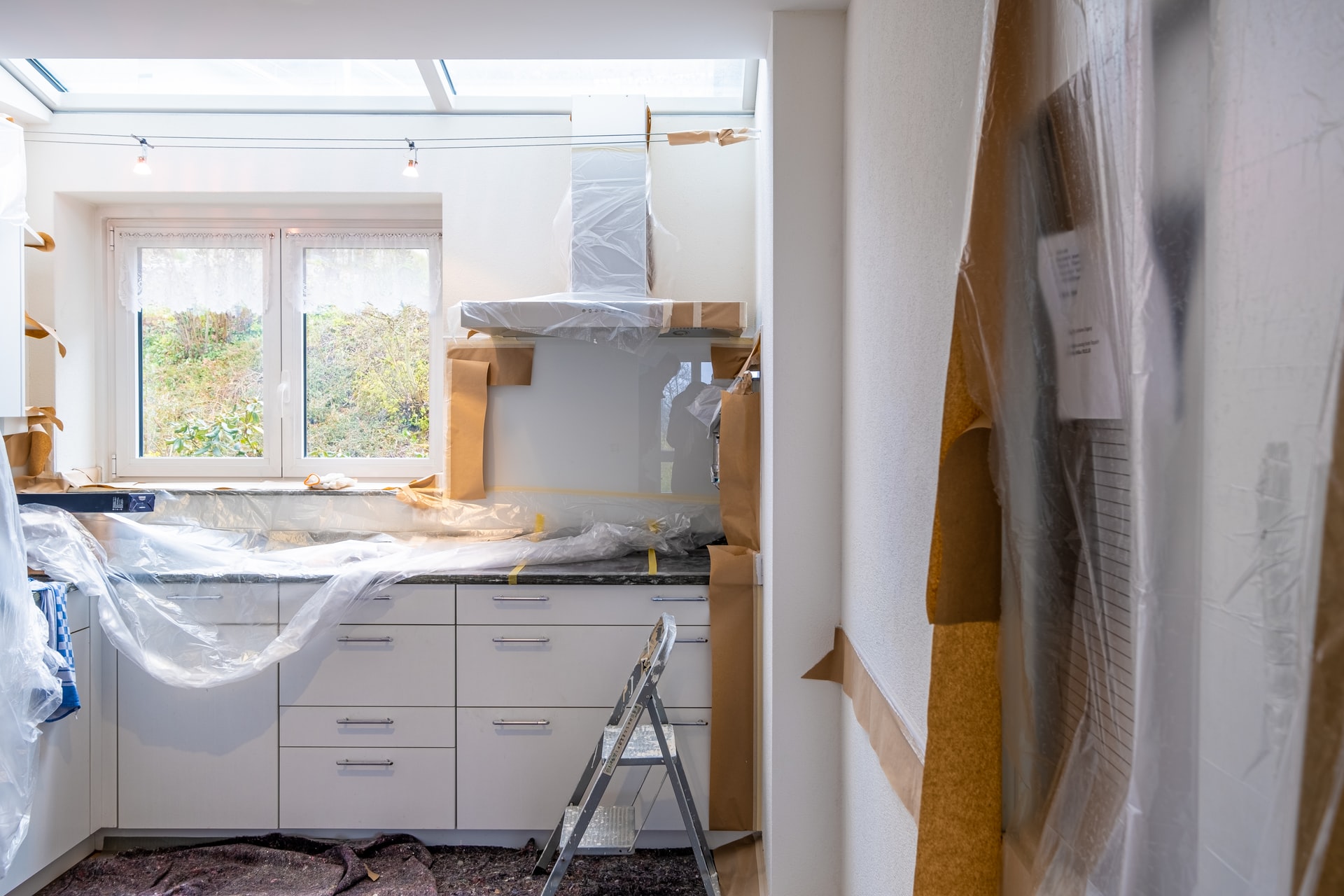The average home renovation costs between $15,000 and $20,000. Some renovations can stretch beyond $20,000, and not every homeowner has enough cash in hand to afford the renovation. Some homeowners can save enough money for the renovation, but not everyone has the luxury of time. Water damage will worsen, and an immediate home renovation is the best solution. Some homeowners prefer to get it over with instead of drawing out the process for several years.
Loans speed up the path to a house renovation. Financing covers the difference when you’re short on funds. You can make monthly payments towards the principal instead of delaying the project. Homeowners can review several financing options, such as construction loans. We’ll cover the pros and cons of these loans and show you how you can provide the necessary funds for your home renovation.
Construction Loans: Overview
Construction loans provide you with enough funds for your house renovation. This short-term financing source is specialty financing that covers custom home-building costs. Borrowers take out construction loans for extensive renovations or constructions. Construction loan lenders provide the principal in chunks based on milestones instead of giving it all to you at once. You’ll have to jump through several hurdles to receive approval for additional funding, such as an inspector’s approval and signature.
Can You Use a Construction Loan for a House Renovation?
You can use a construction loan for a house renovation, but it has to be large in scale. Their high fees and interest rates make them unattractive for homeowners, but using one of these loans is technically possible.
Benefits of Using a Construction Loan for a House Renovation
Construction loans have many disadvantages for homeowners, but they have some benefits. You can borrow more money from the lender since financial institutions assess loan applications based on the post-construction value of the home. For example, if your home is worth $500,000, and the renovation will raise your home’s value to $600,000, you can borrow money as if your home already had the $600,000 valuation.
Construction loans also provide short-term relief from debt. You only owe interest while constructing the property and can hold off on principal payments. While this offers a blanket of security for some homeowners, the post-renovation surprise can cause significant financial stress.
Drawbacks of a Construction Loan for a House Renovation
We’ve covered a few benefits, but construction loans come with substantial risks. We’ve outlined some of their drawbacks below.
- Stringent Requirements and Complicated Process: Lenders take on significant risks with construction loans. They work with borrowers with unfinished properties. Even though you’re only looking for a renovation, lenders will hold onto their stringent credit score and architectural planning requirements. You’ll also have to raise more money for a down payment.
- You Pay More Due to Refinancing: You must refinance your current mortgage if you get a construction loan. Interest rates are already rising, but construction loans have higher rates than mortgage loans. You’ll end up owing more debt if you take out a construction loan. This disadvantage alone stops many homeowners from pursuing this option.
- Higher Closing Costs: Construction loans let you tap into more funds since lenders consider your property’s value after the project gets completed instead of current home equity. However, this structure also leads to higher closing costs. Lenders use a percentage of the loan to determine closing costs. A higher principal translates into more expensive closing costs, limiting your ability to use initial funds for a home renovation.
- You Won’t Get Your Money Right Away: A construction loan isn’t like most financing options. Lenders give you some of the money upfront instead of the entire principal. You will only receive more of the loan amount if the project reaches certain milestones. Any delays with the renovation will further restrict your access to capital.
- Frequent Property Inspections: You’ll need several property inspections before accessing the next allotment of funds. Property inspections on construction sites make more sense. You wouldn’t want to build on a shaky foundation. Home renovations have fewer risks. Inspections can help, but several of them can get overwhelming. You’ll have to call inspectors, meet with them, and have several of them in your home. Not everyone is comfortable with this level of property inspection, but it’s a requirement for each stage of a construction loan.
Types of Construction Loans for Remodeling
Consumers can choose from several loans for their construction or renovation projects. Here are some financing options to consider.
Construction-to-Permanent Loan
These loans give you the financing to buy the materials and complete your construction project. Once the construction is finished, the remaining balance on the home renovation loan becomes a mortgage. This loan can help if you are building a new home or a fixer-upper, as you only have to make interest payments when you are building the property.
Construction-Only Loan
This short-term loan allows you to borrow cash for a construction project. You have to repay the entire loan amount at maturity, which is usually 1-2 years. You can repay the loan by taking out a mortgage or saving up enough cash leading up to the maturity date.
Renovation Construction Loans
The Federal Housing Administration (FHA) has a program that covers this type of loan. Borrowers can purchase and renovate properties and make monthly payments for the same financial product. Some people find it easier to make a single monthly payment instead of having to make monthly payments for multiple loans.
Owner-Builder Loan
Owner-builder loans are short-term loans for builders who want to complete their dream properties on their own. You’ll typically have 12 months before you have to pay back the loan.
Eligibility Criteria for Construction Loans
These are some of the requirements to keep in mind before applying for construction loans. While requirements vary for each lender, here are some of the common parameters.
Credit Score Requirements
You will typically need a credit score of at least 620 to receive a construction loan. This credit score will also give you more options if you end up applying for a permanent mortgage during the construction process. Terms and rates vary, but you will have more favorable offers if you have a higher credit score. It is possible to get a loan even if you have a lower credit score, but you may have to use government-backed programs.
Building your credit over time will help you qualify for different types of loans. Credit repair mostly boils down to making on-time payments, but it is also important to pay off your balances to ensure a low credit utilization ratio.
Income and Employment History
Lenders will review your income and employment history before a major renovation to see if you can make on-time monthly payments. You’ll also have to provide your financial information if you are working on smaller projects. Lenders prefer that you have been consistently employed over the past two years. They’ll also check your debt-to-income ratio.
Your DTI ratio measures the percentage of your income that goes toward debt payments. If you earn $5,000 per month and make $2,000 in monthly debt payments, you have a 40% DTI ratio. Most lenders will accept your application if you have a 40% DTI ratio, but a lower ratio will help you receive a lower interest rate.
Equity and Down Payment Considerations
Most construction loans require high down payments before getting started. While the terms and conditions may differ for your loan program, you may have to put 20% down to be eligible. Homeowners should also review the amount of equity they have in their property. A home equity line of credit or a home equity loan can be useful for remodeling projects if you already have a position in your home. Borrowers who are working on the home construction process should consider how valuable the home will be once it is complete.
Financial Considerations to Take Note Of
Whether you get your loan from Fannie Mae, Freddie Mac, or an alternative lender, it’s important to have a detailed plan. These are some of the ways a construction loan can impact your long-term finances.
Interest Rates and Terms
Loan officers review your credit score, DTI ratio, and other information before deciding on the rate and terms for your loan. The type of loan you receive will impact your rate. For instance, unsecured financial products like personal loans usually have higher rates than loans that use collateral, such as HELOCs.
Homeowners should also consider the length of the loan term. Some construction loans have short terms that only last one year. Not everyone can repay a loan in full after one year. It’s important to keep rates and terms in mind so you find the right loan for you.
Loan Fees and Closing Costs
You can expect several fees when you take out a loan. You’ll have to cover administrative fees, origination fees, and other expenses. Closing costs vary considerably and can get expensive. Some people use the lump sum from their loan to pay off closing costs, while others roll the closing costs into the backend of their loan.
Budgeting for Overruns
Not every construction project goes smoothly. Some projects with 1-year timeframes end up taking 2-3 years instead. Materials and labor may become less available as you go deeper into the project. Anticipating overruns and budgeting accordingly can minimize your total expenses. You’ll also have a backup plan in case you experience an overrun with a short-term loan.
Reasons Why Construction Loans May Not Be the Best Option for a Remodel
Although a construction loan can offer plenty of capital, it’s not the best choice for everyone. These are some of the reasons why a construction loan can be unfavorable.
- High rates: Elevated interest rates will increase your monthly payments. Homebuilders may want to accumulate more cash, build their credit scores, or wait for the Fed to lower rates before taking out new home construction loans. Secured loans like HELOCs usually have lower rates.
- Cash flow: A new construction project does not generate any cash flow. While construction can enhance a property’s value, you will have to make monthly payments without much to show for it in the early stages. Some people can wait for long-term results, while others need the cash flow right now.
- Short-term financing: Some construction loan options have 1-year terms, so you’ll have to pay back the entire lump sum in a short amount of time. Other loans give you more time to make monthly payments.
- The draw process: Some construction loans have complex draw processes that only give out cash once you reach the next construction phase. Having capital locked up in this manner can hurt if you want to capitalize on lower prices for materials that are only needed for the next step of the construction process.
Reasons Why Contractors Don’t Like Construction Loans
It’s not just homeowners who struggle with construction loans. Many contractors do not enjoy working with these loans. They would prefer financing from another loan or for the construction company to provide the cash. So why would the professionals not want these loans? We offer some reasons below.
- Require a Lot of Work: You’ll have to jump through several hurdles to access each portion of the principal loan. Financial institutions take on a substantial risk when lending money to contractors. They will complicate the process if it keeps their money safe.
- Slow Down the Project: Since contractors won’t receive the funds right away, they may get financially trapped earlier than expected. Several inspectors have to review the current structure before you can move to the next stage of funding. You’ll have to schedule meetings with inspectors selected by the bank and then approach your lender with the signatures. These delays can add weeks to each step of the construction and limit a contractor’s ability to take on new projects.
- Lots of Paperwork: Both of these disadvantages involve paperwork. You’ll need the right documents for each draw. Conventional loans only require paperwork once. Once you get a traditional loan, you can use all of the funds. Paperwork for a construction loan will accumulate and can make your mind numb. Contractors already have a lot of responsibilities to juggle with their projects. Additional paperwork slows them down and leads to stress.
Looking for an Alternative to a Construction Loan for Remodel?
Homeowners can choose from several alternatives to a construction loan remodel. These are some of the available choices.
Personal Loans
These unsecured loans have terms that typically range from 2-7 years. You will make fixed monthly payments until the loan matures. A higher credit score will help you get better rates and terms, but some personal loan providers have more generous credit score requirements.
Credit Card
You can go into credit card debt to fund a construction project. However, credit card interest rates range from 19.99% APR to 29.99% APR in most cases. Credit cards also have limits that restrict how high your balance can become. While it’s a financial product to consider, it’s definitely not the best option available.
Government Loans
The government offers several loans that make it possible for people to buy and remodel their homes. FHA loans, USDA loans, and VA loans are the most common options. These loans tend to have lower credit score requirements than Fannie Mae and Freddie Mac loans.
Home Equity Loans
Home equity loans allow you to tap into the equity you have built into your home over the years. Homeowners build equity by making a down payment, paying the mortgage each month, and waiting for their properties to appreciate. These loans can have terms as long as 30 years, allowing you to preserve the current rate and term on your mortgage.
They’re essentially second mortgages, which means an additional monthly payment. Most home equity loans have fixed interest rates, which means the monthly payments stay the same.
HELOCs
Home equity lines of credit are another useful financial product to consider. These products also let you borrow equity against your home, but they have variable interest rates. Variable rates result in fluctuating monthly payments. You can also get away with making interest-only payments during the draw period. After the draw period concludes, you will have to pay off the remaining balance or convert it to a loan.
Some borrowers pay off their HELOCs before the draw period concludes. In that case, you can borrow from the HELOC again since it is a revolving line of credit. You only pay interest on a HELOC when you borrow against the credit line. If you pay back the credit line, you won’t pay interest unless you borrow from it again.
Cash-out Refinance
A cash-out refinance allows you to swap your current mortgage for a new one. People refinance their properties for several reasons, but a cash-out refinance involves tapping into home equity. Homeowners can also add more years to their new mortgage to keep the monthly payments at a similar level.
This financial product helps you avoid a second mortgage. However, the closing costs are more expensive for cash-out refinances since a new mortgage has a higher loan amount than a HELOC or a home equity loan. Closing costs are based on a percentage of the loan’s amount.
A cash-out refinance is not a good option if you secured a low interest rate for your current mortgage. You can’t carry over a favorable interest rate and terms from your current mortgage to your new one. A second mortgage may be a better choice if you received your current mortgage when interest rates were at record lows.
Choosing the Right Financing Option for a Remodel
A home renovation project can get expensive. You’ll have to complete several phases, each of which can have delays or higher costs than anticipated. Choosing the right financing option for your remodel can help you save money and make the repayment process more reasonable.
It’s a good idea to compare several lenders before deciding on the right loan for you. Borrowers should assess each loan’s rate and terms, and browsing through online reviews can also lead to a better decision. As you review more loan offers, you will get a better idea of which loan is optimal for your remodeling project.







